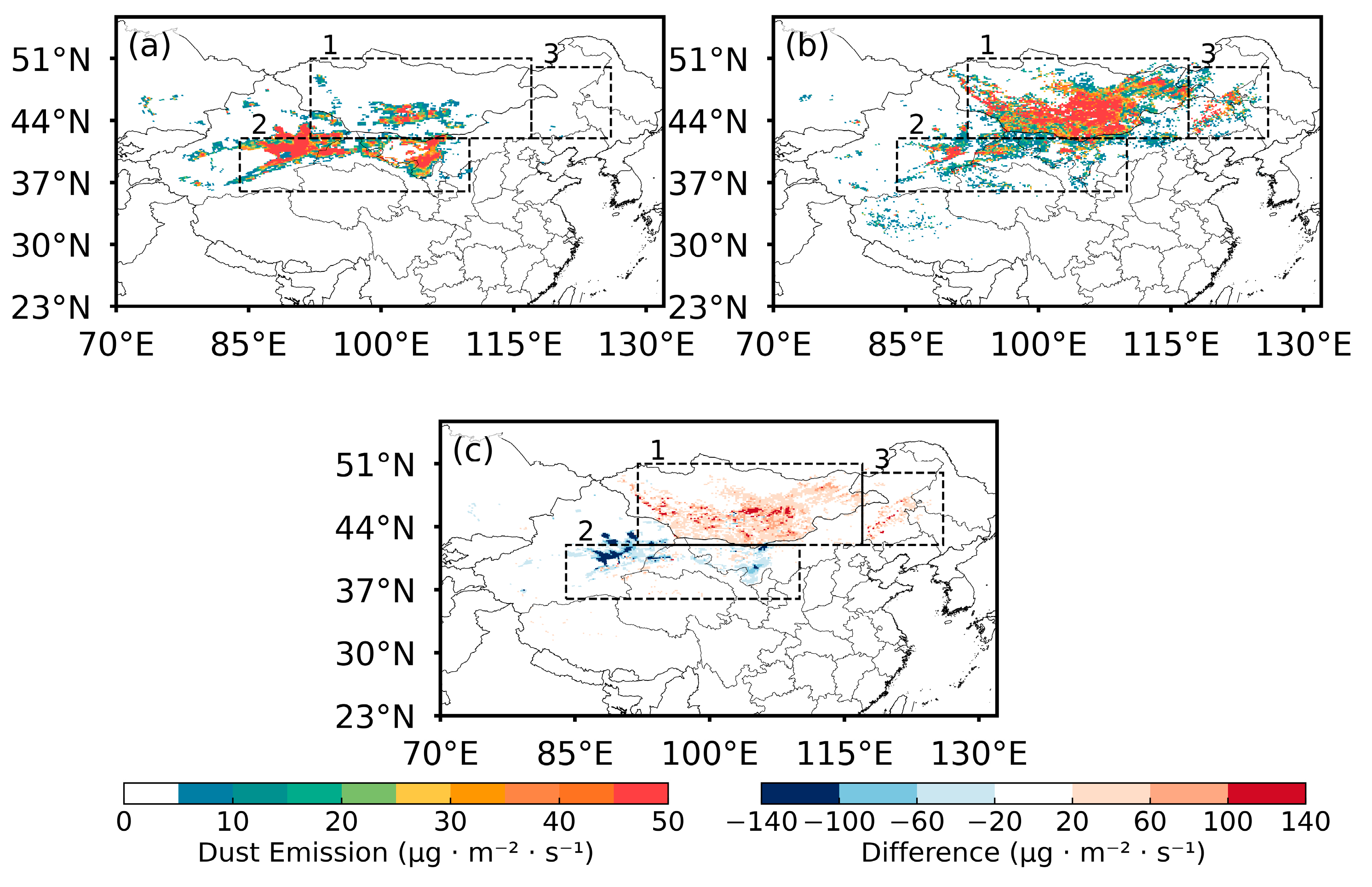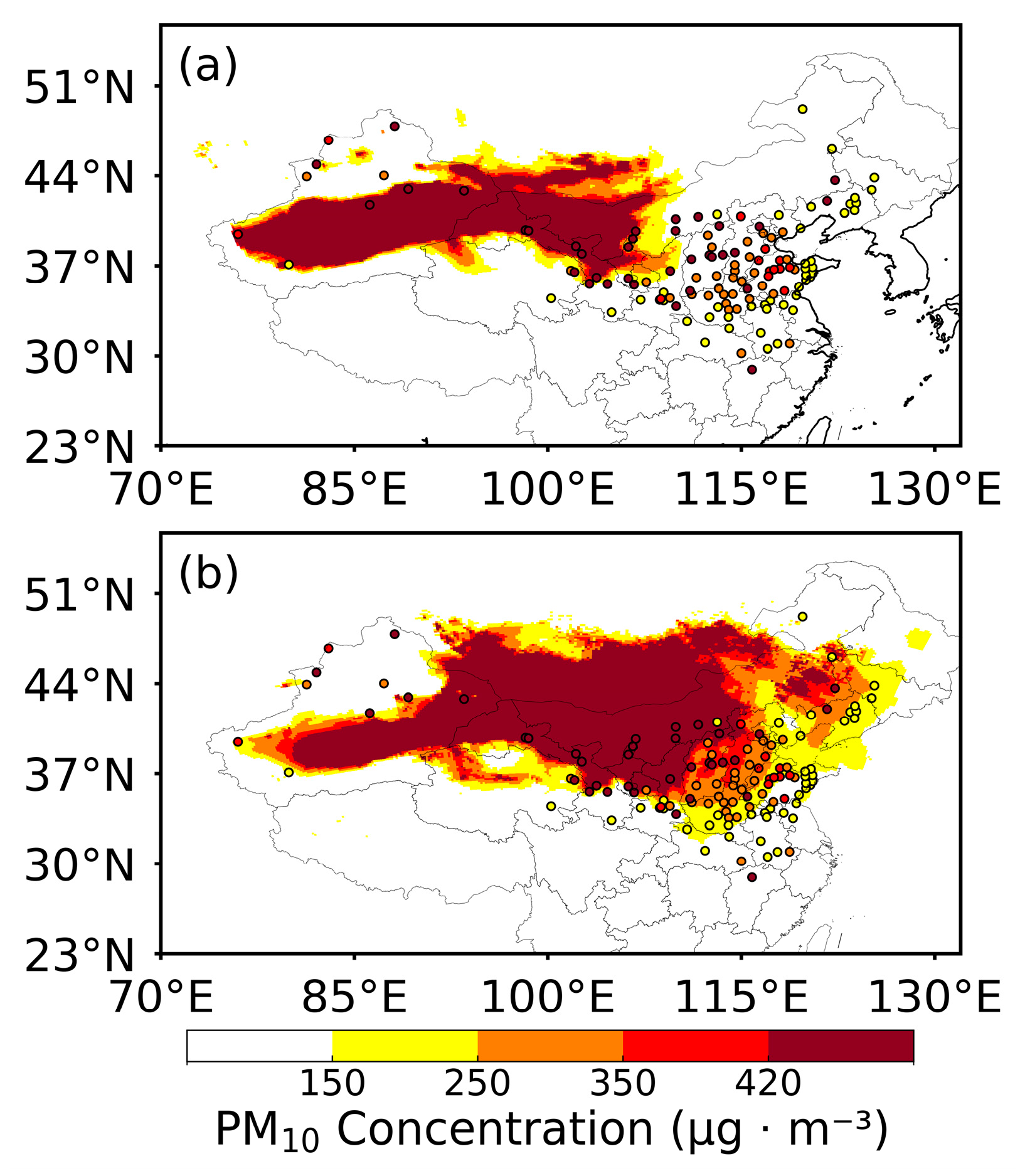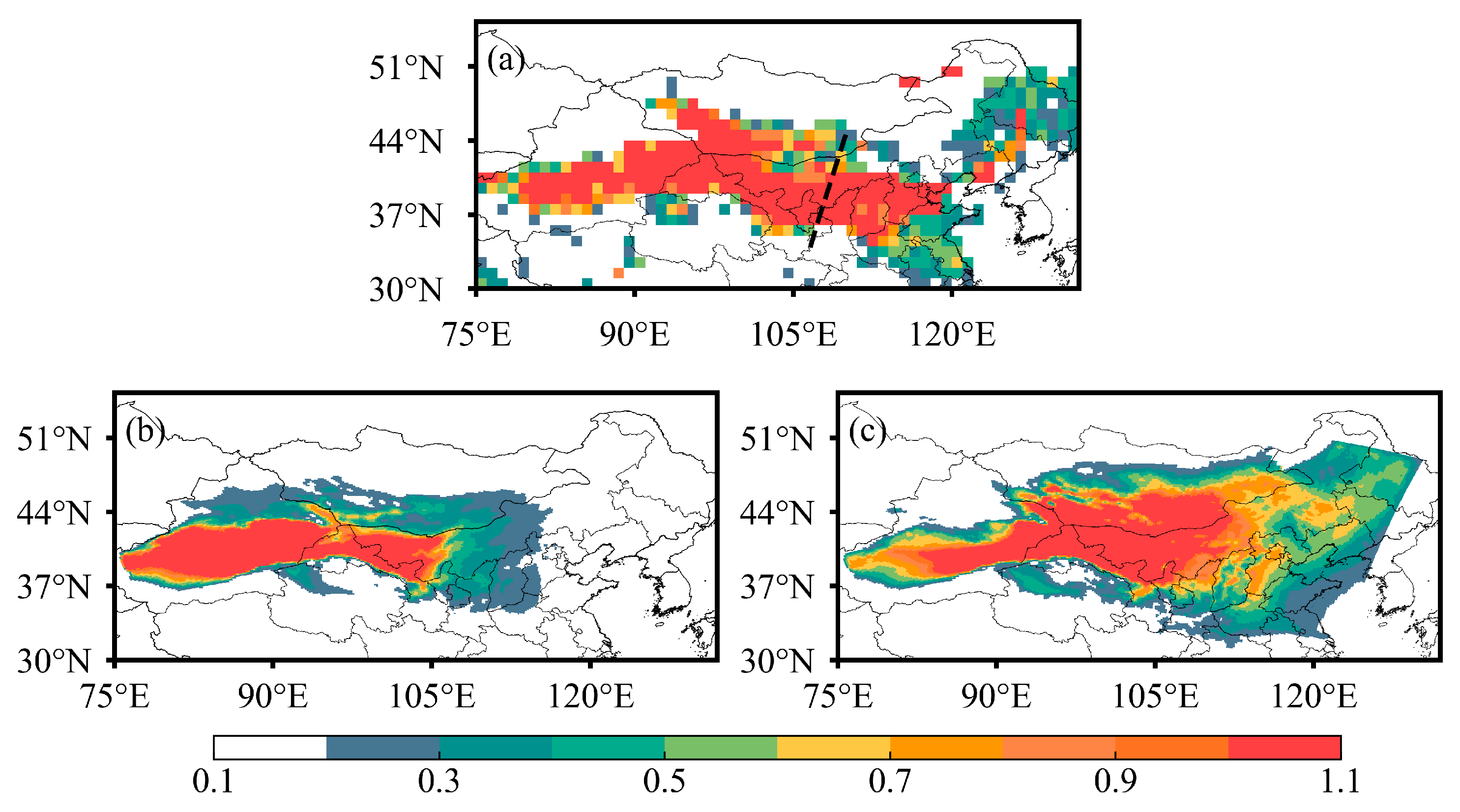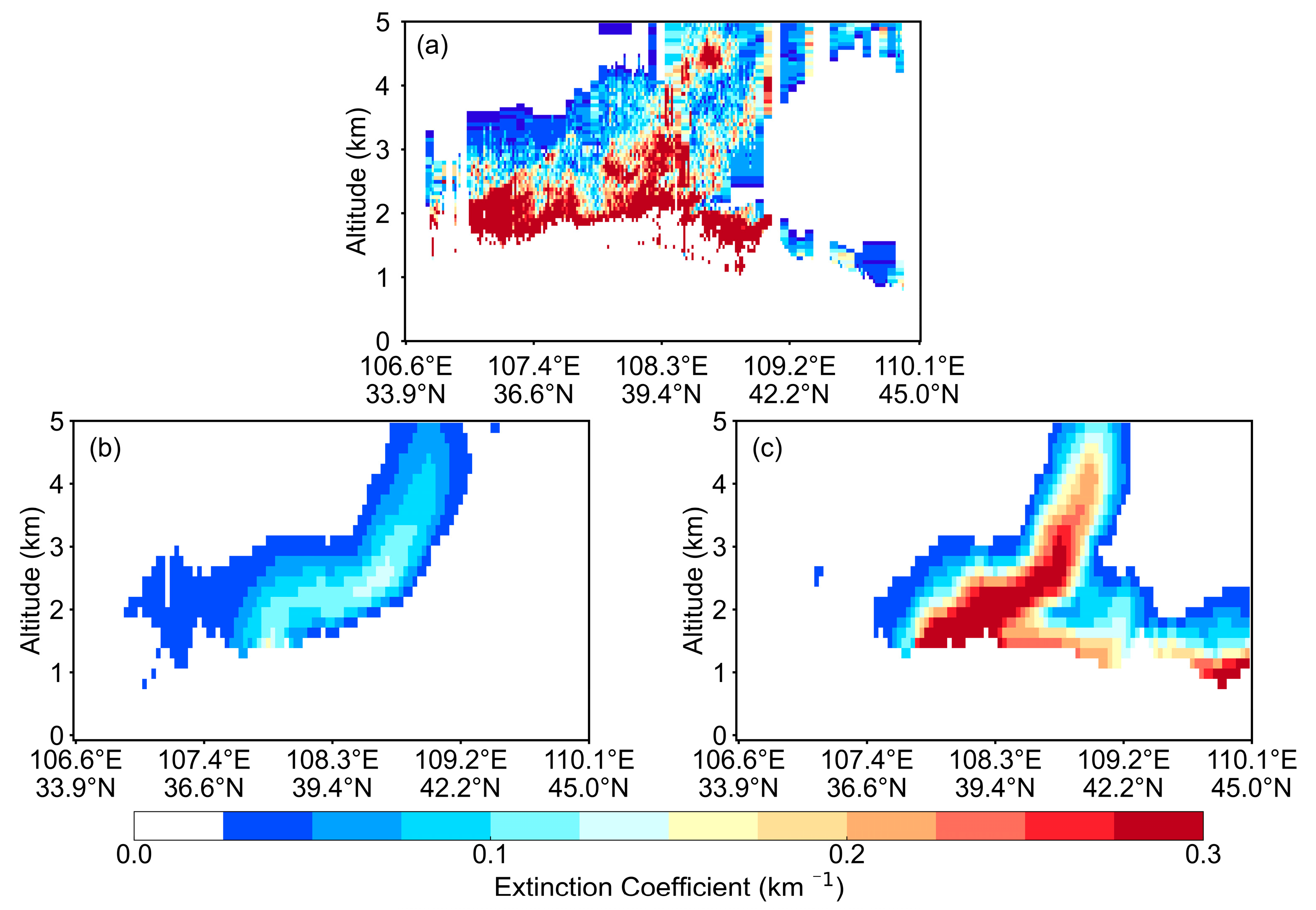A Dynamically Updated Dust Source Function for Dust Emission Scheme: Improving Dust Aerosol Simulation on an East Asian Dust Storm
Abstract
1. Introduction
2. Methodology
2.1. Update of Dust Source Function
2.2. Model Configuration
2.3. Data
3. Results and Discussion
3.1. Comparison of DSF
3.2. Near-Surface Meteorology
3.3. Changes in Dust Emissions
3.4. PM10 Concentrations
3.5. DOD Distribution
3.6. Aerosol Extinction Coefficient
4. Conclusions and Discussion
Author Contributions
Funding
Institutional Review Board Statement
Informed Consent Statement
Data Availability Statement
Conflicts of Interest
References
- Shao, Y.; Wyrwoll, K.-H.; Chappell, A.; Huang, J.; Lin, Z.; McTainsh, G.H.; Mikami, M.; Tanaka, T.Y.; Wang, X.; Yoon, S. Dust cycle: An emerging core theme in Earth system science. Aeolian Res. 2011, 2, 181–204. [Google Scholar] [CrossRef]
- Kok, J.F.; Ward, D.S.; Mahowald, N.M.; Evan, A.T. Global and regional importance of the direct dust-climate feedback. Nat. Commun. 2018, 9, 241. [Google Scholar] [CrossRef] [PubMed]
- Cwiertny, D.M.; Young, M.A.; Grassian, V.H. Chemistry and photochemistry of mineral dust aerosol. Annu. Rev. Phys. Chem. 2008, 59, 27–51. [Google Scholar] [CrossRef] [PubMed]
- Mahowald, N.M.; Scanza, R.; Brahney, J.; Goodale, C.L.; Hess, P.G.; Moore, J.K.; Neff, J. Aerosol Deposition Impacts on Land and Ocean Carbon Cycles. Curr. Clim. Change Rep. 2017, 3, 16–31. [Google Scholar] [CrossRef]
- Fussell, J.C.; Kelly, F.J. Mechanisms underlying the health effects of desert sand dust. Environ. Int. 2021, 157, 106790. [Google Scholar] [CrossRef]
- Gherboudj, I.; Beegum, S.N.; Ghedira, H. Identifying natural dust source regions over the Middle-East and North-Africa: Estimation of dust emission potential. Earth-Sci. Rev. 2017, 165, 342–355. [Google Scholar]
- Ukhov, A.; Ahmadov, R.; Grell, G.; Stenchikov, G. Improving dust simulations in WRF-Chem v4.1.3 coupled with the GOCART aerosol module. Geosci. Model Dev. 2021, 14, 473–493. [Google Scholar]
- Kok, J.F.; Adebiyi, A.A.; Albani, S.; Balkanski, Y.; Checa-Garcia, R.; Chin, M.; Colarco, P.R.; Hamilton, D.S.; Huang, Y.; Ito, A.; et al. Contribution of the world’s main dust source regions to the global cycle of desert dust. Atmos. Chem. Phys. 2021, 21, 8169–8193. [Google Scholar]
- Zender, C.S.; Miller, R.; Tegen, I. Quantifying mineral dust mass budgets: Terminology, constraints, and current estimates. Eos Trans. Am. Geophys. Union 2004, 85, 509–512. [Google Scholar]
- Kok, J.F.; Adebiyi, A.A.; Albani, S.; Balkanski, Y.; Checa-Garcia, R.; Chin, M.; Colarco, P.R.; Hamilton, D.S.; Huang, Y.; Ito, A.; et al. Improved representation of the global dust cycle using observational constraints on dust properties and abundance. Atmos. Chem. Phys. 2021, 21, 8127–8167. [Google Scholar]
- Kok, J.F.; Storelvmo, T.; Karydis, V.A.; Adebiyi, A.A.; Mahowald, N.M.; Evan, A.T.; He, C.; Leung, D.M. Mineral dust aerosol impacts on global climate and climate change. Nat. Rev. Earth Environ. 2023, 4, 71–86. [Google Scholar] [CrossRef]
- Tanaka, T.Y.; Chiba, M. A numerical study of the contributions of dust source regions to the global dust budget. Glob. Planet. Change 2006, 52, 88–104. [Google Scholar] [CrossRef]
- Gavrouzou, M.; Hatzianastassiou, N.; Gkikas, A.; Korras-Carraca, M.-B.; Mihalopoulos, N. A Global Climatology of Dust Aerosols Based on Satellite Data: Spatial, Seasonal and Inter-Annual Patterns over the Period 2005–2019. Remote Sens. 2021, 13, 359. [Google Scholar] [CrossRef]
- Castellanos, P.; Colarco, P.; Espinosa, W.R.; Guzewich, S.D.; Levy, R.C.; Miller, R.L.; Chin, M.; Kahn, R.A.; Kemppinen, O.; Moosmüller, H.; et al. Mineral dust optical properties for remote sensing and global modeling: A review. Remote Sens. Environ. 2024, 303, 113982. [Google Scholar] [CrossRef]
- Kim, D.; Chin, M.; Schuster, G.; Yu, H.; Takemura, T.; Tuccella, P.; Ginoux, P.; Liu, X.; Shi, Y.; Matsui, H.; et al. Where Dust Comes From: Global Assessment of Dust Source Attributions With AeroCom Models. J. Geophys. Res. Atmos. 2024, 129, e2024JD041377. [Google Scholar] [CrossRef]
- Zhang, K.; Chai, F.; Zhang, R.; Xue, Z. Source, route and effect of Asian sand dust on environment and the oceans. Particuology 2010, 8, 319–324. [Google Scholar] [CrossRef]
- Huang, J.; Wang, T.; Wang, W.; Li, Z.; Yan, H. Climate effects of dust aerosols over East Asian arid and semiarid regions. J. Geophys. Res. Atmos. 2014, 119, 11398–11416. [Google Scholar] [CrossRef]
- Yu, Y.; Kalashnikova, O.V.; Garay, M.J.; Notaro, M. Climatology of Asian dust activation and transport potential based on MISR satellite observations and trajectory analysis. Atmos. Chem. Phys. 2019, 19, 363–378. [Google Scholar] [CrossRef]
- Tian, Y.; Wang, Z.; Pan, X.; Li, J.; Yang, T.; Wang, D.; Liu, X.; Liu, H.; Zhang, Y.; Lei, S.; et al. Influence of the morphological change in natural Asian dust during transport: A modeling study for a typical dust event over northern China. Sci. Total Environ. 2020, 739, 139791. [Google Scholar] [CrossRef]
- Shao, Y.; Ishizuka, M.; Mikami, M.; Leys, J.F. Parameterization of size-resolved dust emission and validation with measurements. J. Geophys. Res. 2011, 116, D08203. [Google Scholar] [CrossRef]
- Gong, S.L.; Zhang, X.Y.; Zhao, T.L.; McKendry, I.G.; Jaffe, D.A.; Lu, N.M. Characterization of soil dust aerosol in China and its transport and distribution during 2001 ACE-Asia: 2. Model simulation and validation. J. Geophys. Res. Atmos. 2003, 108, 4262. [Google Scholar]
- Kok, J.F.; Parteli, E.J.; Michaels, T.I.; Karam, D.B. The physics of wind-blown sand and dust. Rep. Prog. Phys. 2012, 75, 106901. [Google Scholar]
- Ginoux, P.; Chin, M.; Tegen, I.; Prospero, J.M.; Holben, B.; Dubovik, O.; Lin, S.J. Sources and distributions of dust aerosols simulated with the GOCART model. J. Geophys. Res. Atmos. 2001, 106, 20255–20273. [Google Scholar] [CrossRef]
- Koven, C.D.; Fung, I. Identifying global dust source areas using high-resolution land surface form. J. Geophys. Res. Atmos. 2008, 113, D22204. [Google Scholar]
- Cremades, P.G.; Fernández, R.P.; Allende, D.G.; Mulena, G.C.; Puliafito, S.E. High resolution satellite derived erodibility factors for WRF/Chem windblown dust simulations in Argentina. Atmósfera 2017, 30, 11–25. [Google Scholar]
- Nabavi, S.O.; Haimberger, L.; Samimi, C. Sensitivity of WRF-chem predictions to dust source function specification in West Asia. Aeolian Res. 2017, 24, 115–131. [Google Scholar]
- Liang, P.; Chen, B.; Yang, X.; Liu, Q.; Li, A.; Mackenzie, L.; Zhang, D. Revealing the dust transport processes of the 2021 mega dust storm event in northern China. Sci. Bull. 2022, 67, 21–24. [Google Scholar]
- Idrissa, N.F.; Zhao, C.; Zhiyuan, H.; Feng, J.; Du, Q. Long-range transport impact of a severe dust storm over the Yangtze River Basin region and its modeling sensitivity to dust emission scheme. Atmos. Res. 2024, 310, 107612. [Google Scholar]
- Grini, A.; Myhre, G.; Zender, C.S.; Isaksen, I.S.A. Model simulations of dust sources and transport in the global atmosphere: Effects of soil erodibility and wind speed variability. J. Geophys. Res. Atmos. 2005, 110, D02205. [Google Scholar]
- Shinoda, M.; Gillies, J.A.; Mikami, M.; Shao, Y. Temperate grasslands as a dust source: Knowledge, uncertainties, and challenges. Aeolian Res. 2011, 3, 271–293. [Google Scholar] [CrossRef]
- Reynolds, C.A.; Jackson, T.J.; Rawls, W.J. Estimating soil water-holding capacities by linking the Food and Agriculture Organization Soil map of the world with global pedon databases and continuous pedotransfer functions. Water Resour. Res. 2000, 36, 3653–3662. [Google Scholar] [CrossRef]
- Shangguan, W.; Dai, Y.; Duan, Q.; Liu, B.; Yuan, H. A global soil data set for earth system modeling. J. Adv. Model. Earth Syst. 2014, 6, 249–263. [Google Scholar] [CrossRef]
- LeGrand, S.L.; Polashenski, C.; Letcher, T.W.; Creighton, G.A.; Peckham, S.E.; Cetola, J.D. The AFWA dust emission scheme for the GOCART aerosol model in WRF-Chem v3.8.1. Geosci. Model Dev. 2019, 12, 131–166. [Google Scholar] [CrossRef]
- Marticorena, B.; Bergametti, G. Modeling the atmospheric dust cycle: 1. Design of a soil-derived dust emission scheme. J. Geophys. Res. Atmos. 1995, 100, 16415–16430. [Google Scholar] [CrossRef]
- Vermote, E.F.; Roger, J.C.; Ray, J.P. MODIS Surface Reflectance User’s Guide Collection 6; NASA EOSDIS Land Processes Distributed Active Archive Center: Sioux Falls, SD, USA, 2015. Available online: https://lpdaac.usgs.gov/documents/306/MOD09_User_Guide_V6.pdf (accessed on 15 February 2025).
- Solano, R.; Didan, K.; Jacobson, A.; Huete, A. MODIS Vegetation Index User’s Guide (MOD13 Series); University of Arizona, Vegetation Index and Phenology Lab: Tucson, AZ, USA, 2015; pp. 1–38. [Google Scholar]
- Hall, D.K.; Riggs, G.A. MODIS/Terra Snow Cover 8-Day L3 Global 500m SIN Grid, Version 61; NASA National Snow and Ice Data Center Distributed Active Archive Center: Boulder, CO, USA, 2021; Available online: https://doi.org/10.5067/MODIS/MOD10A2.061 (accessed on 15 February 2025).
- Sulla-Menashe, D.; Friedl, M.A. User Guide to Collection 6 MODIS Land Cover (MCD12Q1 and MCD12C1) Product; USGS: Reston, VA, USA, 2018. [Google Scholar]
- Anderson, T.L.; Wu, Y.; Chu, D.A.; Schmid, B.; Redemann, J.; Dubovik, O. Testing the modis satellite retrieval of aerosol fine-mode fraction. J. Geophys. Res. Atmos. 2005, 110, D18204. [Google Scholar] [CrossRef]
- Song, Q.; Zhang, Z.; Yu, H.; Ginoux, P.; Shen, J. Global dust optical depth climatology derived from CALIOP and MODIS aerosol retrievals on decadal timescales: Regional and interannual variability. Atmos. Chem. Phys. 2021, 21, 13369–13395. [Google Scholar] [CrossRef]





| Option Name | Scheme |
|---|---|
| Boundary layer | ACM2 |
| Land surface | Unified Noah |
| Surface layer | MM5 Monin-Obukhov |
| Microphysics | Morrison-2 |
| Long wave radiation | RRTMG |
| Short wave radiation | RRTMG |
| Cumulus | Grell-3 |
| Dust emission scheme | AFWA |
| Factor | R | ME | RMSE |
|---|---|---|---|
| 2 m air temperature (T2) | 0.88 | 0.50 | 2.71 |
| relative humidity (RH) | 0.86 | 1.81 | 12.2 |
| 10 m wind speed (W10) | 0.59 | 1.37 | 2.17 |
| Factor | R | ME | RMSE |
|---|---|---|---|
| PM10 (with the default DSF) | 0.32 | −325.30 | 666.63 |
| PM10 (with the updated DSF) | 0.64 | −109.30 | 564.53 |
Disclaimer/Publisher’s Note: The statements, opinions and data contained in all publications are solely those of the individual author(s) and contributor(s) and not of MDPI and/or the editor(s). MDPI and/or the editor(s) disclaim responsibility for any injury to people or property resulting from any ideas, methods, instructions or products referred to in the content. |
© 2025 by the authors. Licensee MDPI, Basel, Switzerland. This article is an open access article distributed under the terms and conditions of the Creative Commons Attribution (CC BY) license (https://creativecommons.org/licenses/by/4.0/).
Share and Cite
Tan, C.; Liu, C.; Li, T.; Luan, Z.; Tang, M.; Zhao, T. A Dynamically Updated Dust Source Function for Dust Emission Scheme: Improving Dust Aerosol Simulation on an East Asian Dust Storm. Atmosphere 2025, 16, 357. https://doi.org/10.3390/atmos16040357
Tan C, Liu C, Li T, Luan Z, Tang M, Zhao T. A Dynamically Updated Dust Source Function for Dust Emission Scheme: Improving Dust Aerosol Simulation on an East Asian Dust Storm. Atmosphere. 2025; 16(4):357. https://doi.org/10.3390/atmos16040357
Chicago/Turabian StyleTan, Chenghao, Chong Liu, Tian Li, Zhaopeng Luan, Mingjin Tang, and Tianliang Zhao. 2025. "A Dynamically Updated Dust Source Function for Dust Emission Scheme: Improving Dust Aerosol Simulation on an East Asian Dust Storm" Atmosphere 16, no. 4: 357. https://doi.org/10.3390/atmos16040357
APA StyleTan, C., Liu, C., Li, T., Luan, Z., Tang, M., & Zhao, T. (2025). A Dynamically Updated Dust Source Function for Dust Emission Scheme: Improving Dust Aerosol Simulation on an East Asian Dust Storm. Atmosphere, 16(4), 357. https://doi.org/10.3390/atmos16040357






